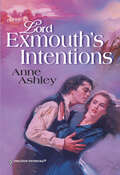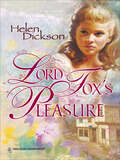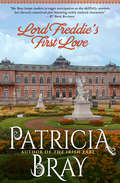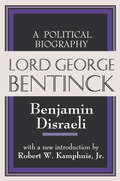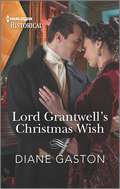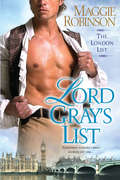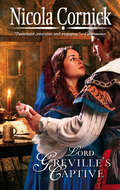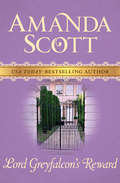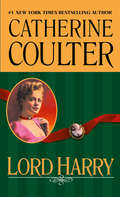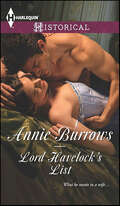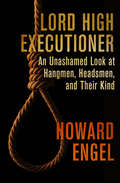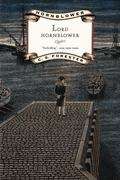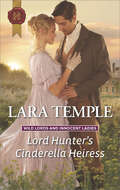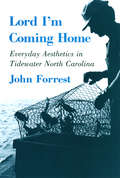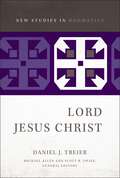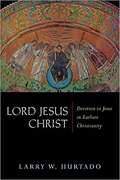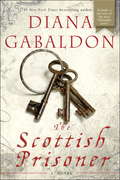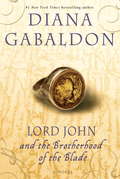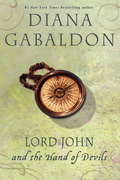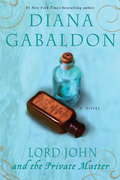- Table View
- List View
Lord Exmouth's Intentions
by Anne AshleyA young woman disappears. A husband is suspected of murder. Stirring times for all the neighborhood.Demure vicar's daughter Robina Percival has relished her Season in Town-a definite change for the better after her somewhat straitened situation at home. But what is she to make of Daniel, Lord Exmouth? A widower with two daughters to raise, he appears to be in the market for a wife. Discovering that she has more spirit than she realized, Robina holds back from encouraging her potential suitor. How can she be sure he hasn't buried his heart with his beautiful wife?Regency DramaIntrigue, mischief...and marriageThe Steepwood Scandal
Lord Fox's Pleasure
by Helen DicksonMARRIAGE IN MINDWith the restoration of King Charles II to the throne, his exiled supporters were jubilantly returning home, wealthy landowner Lucas Fox among them. Once a notorious pleasure seeker, Lord Fox now found himself ready to settle down to a quiet life on his estate. All that was missing was a wife....Proud and impulsive Prudence Fairworthy captured his interest-and made his blood run hot. Pru was suspicious of his true motives and the mystery surrounding his past, and Lucas knew she would not be won over easily. But there was untold pleasure to be found in the art of persuasion....
Lord Freddie's First Love
by Patricia BrayA viscount is enraptured—but gossips might get in the way of romance—in this Regency tale by an author acclaimed for &“absorbing storytelling&” (Booklist). Despite having proposed to more than a dozen women, Viscount Frederick remains one of London&’s most eligible bachelors. The debutantes simply don&’t find him dashing enough for their tastes. His pride stinging from his latest rejection, Freddie leaves London for his country estate. After six years abroad, Anne Webster has returned to New Biddeford with a child at her side—a child whose unruly red hair and mischievous green eyes leave society gossips quite sure of the identity of his mother. Though five-year-old Ian is really Anne&’s nephew, nothing could quiet the scandal or erase the stigma once the ton started talking. Anne&’s childhood companion, Viscount Frederick, was the only person to offer friendship—and then, a rapturous love. But how could Anne allow Freddie to destroy his life by marrying a woman with a tarnished reputation such as hers?
Lord Gawain's Forbidden Mistress
by Carol TownendForbidden fruit always tastes the sweetest... Elise keeps her cards close to her chest. Few people know that she's also Blanchefleur le Fay, the celebrated singer. But she has an even greater secret... Her baby daughter is the result of a brief but intense affair with Gawain, Count of Meaux. Duty-bound to marry, Gawain is back in Troyes to meet his bride. So why can't he stop thinking about the sweet, silver-voiced girl he met the last time he was there? And when he finds his mistress again, Gawain must choose between duty and forbidden desire... Knights of Champagne Three Swordsmen for Three Ladies
Lord George Bentinck: A Political History
by Benjamin DisraeliLord George Bentinck is an account of Disraeli's relation with his parliamentary colleague and friend. It is not simply an account of the battle over the Corn Laws with Sir Robert Peel, but a most remarkable book, extremely readable, and full of often quoted and apt comments and descriptions. As a vivid story of one of the great parliamentary dramas in British history it is unsurpassed. The portraits of both Bentinck and Peel are both sympathetic and just. The book provides insight into mid-nineteenth century parliamentary life that remains unsurpassed.It is hard to overstate the bitterness and fury which Peel's decision to repeal the Corn Laws had provoked in British politics. One biographer of Disraeli, Robert Blake, spoke of "Home Rule in 1886 and Munich in 1938 as the nearest parallels". Friendships were sundered, families divided, and the feuds of politics carried into private life to a degree quite unusual in British history. Those who are interested in the details of parliamentary warfare which raged until Peel's fall from power should consult Lord George Bentinck. But the worth of this book goes beyond constitutional history or even the Irish food famine. Disraeli helps explain the intellectual and ideological grounds of the Young England Movement: a conservative force that aimed at a union of discontented industrial workers with aristocratic landowners and against factious Whigs, selfish factory owners and dissenting shopkeepers. In forging such a policy of principle, the Conservatives, as Disraeli's book well demonstrates, became a minority party but one which carried the full weight of moral politics.
Lord Grantwell's Christmas Wish (Captains of Waterloo #2)
by Diane GastonHe wished to never see her againNow he wishes she&’ll stay…Lord Grantwell hasn&’t seen Lillian Pearson since she betrayed him years ago. So when she arrives on his doorstep looking for sanctuary, he&’s not inclined to offer it! But when the two orphaned children in his care ask if she can stay for Christmas, how can he refuse? Grant and Lillian discover an intense attraction still simmers between them, and Grant starts to wonder if he has done her a grave injustice…From Harlequin Historical: Your romantic escape to the past.Captains of WaterlooBook 1: Her Gallant Captain at WaterlooBook 2: Lord Grantwell's Christmas Wish
Lord Gray's List (London List #1)
by Maggie RobinsonA dashing British lord sets out to destroy a slanderous tabloid in this Regency romance by the author of the Courtesan Court series.From duchesses to chamber maids, everybody&’s reading it. Each Tuesday, The London List appears, filled with gossip and scandal, offering job postings and matches for the lovelorn—and most enticing of all, telling the tales and selling the wares a more modest publication wouldn&’t touch . . .The creation of Evangeline Ramsey, The London List saved her and her ailing father from destitution. But the paper has given Evie more than financial relief. As its publisher, she lives as a man, dressed in masculine garb, free to pursue and report whatever she likes—especially the latest disgraces besmirching Lord Benton Gray. It&’s only fair that she hang his dirty laundry, given that it was his youthful ardor that put her off marriage for good . . .Lord Gray—Ben—isn&’t about to stand by while all of London laughs at his peccadilloes week after week. But once he discovers that the publisher is none other than pretty Evie Ramsey with her curls lopped short—his worries turn to desires—and not a one of them fit to print . . .&“A charming, fun Regency romp that combines an innovative, compelling plot with characters that jump off the page and a hot, captivating romance that will tug at heartstrings.&” —Kirkus Reviews &“[An] appealing tale of sin and redemption. . . . [A] witty, raunchy comedy . . . Pure fun.&” —Publishers Weekly
Lord Greville's Captive
by Nicola CornickThe English Civil War tests the bonds between a lord and lady engaged to be married in this historical romance.Years before, he had come to Grafton Manor to be betrothed to the innocent and beautiful Lady Anne—a promise that was broken with the onset of war. . . .Now Simon, Lord Greville, has returned as an enemy, besieging the manor and holding its lady hostage. Simon’s devotion to his cause swayed by his desire for Anne, he will not settle for the manor house alone. He will have the lady—and her heart—into the bargain!Yet Anne has a secret that must be kept from him at all costs. . . .
Lord Greyfalcon's Reward
by Amanda ScottShe knew all about his womanizing reputation, but wasn't prepared for his charmWhen Sylvia Jensen-Graham travels to London to inform her country neighbor, the new Earl of Greyfalcon, that his recently widowed mama needs him, she little realizes that she'll need to employ trickery just to see the Earl. But the Dowager Countess's complaints about her health and her rakish son have been driving Sylvia to distraction, so she poses as a messenger and boldly enters Greyfalcon's club. He unmasks her but soon begins minding his affairs--and Sylvia's--until Sylvia fears that she'll need rescuing from the consequences of her own good deed.
Lord Hadleigh's Rebellion
by Paula MarshallRussell Chancellor, Lord Hadleigh, found the love of his life over a decade ago, but she was forced to marry elsewhere. When a chance meeting at a house party unites him with Mary Wardour once more, both realize that the feelings between them have never died.Mary is now a widow and free to marry. Russell needs to marry or forgo his inheritance. But they have to discover the truth behind the secrets and betrayals that drove them apart before they can hope to find future happiness together....
Lord Harry
by Catherine CoulterA duel of hearts from the #1 New York Times bestselling author. Henrietta Rolland has assumed the guise of a gentleman to track down and kill the man she believes is responsible for her brother's death at the Battle of Waterloo. Unfortunately, things don't quite go as planned...
Lord Havelock's List
by Annie BurrowsAn aristocrat offers a convenient marriage to a woman he believes will be an obedient wife, but his bride is more spirited—and alluring—than he imagined.Be careful what you wish for . . . . Lord Havelock is in need of a wife. But with no time for a society wedding and no stomach for girlish fripperies, his options are limited. So with help from his friends, he draws up a list of qualities he does desire in a wife . . . . When orphaned Mary Carpenter discovers her handsome new husband’s list, she’s hurt—and incensed. If he thinks she’ll sit meekly by, be “compliant” and “a mouse,” he’s got another think coming! Is it perhaps time for Mary to make a list of her own, and change the rules of their relationship forever. . . ?
Lord Hawkridge's Secret
by Anne AshleyMiss Emily Stapleton broke her engagement to Lord Sebastian Hawkridge nearly five years ago upon discovering that he was in love with another. Now she's become entangled in something dark and dangerous and Sebastian is back in her life again-as her guardian! How will Emily respond to him when all the secrets of the past are finally revealed?
Lord High Executioner: An Unashamed Look at Hangmen, Headsmen, and Their Kind
by Howard EngelA grisly tour of hangings, electrocutions, beheadings—and other state-sanctioned deaths that are part of the long history of the death penalty. In Lord High Executioner, award-winning writer Howard Engel traces the traditions of capital punishment from medieval England and early Canada to the present-day United States. Throughout &“civilized&” history, executioners employed on behalf of the kingdom, republic, or dictatorship have beheaded, chopped, stabbed, choked, gassed, electrocuted, or beaten criminals to death—and Engel doesn&’t shy away from the gritty details of the executioner&’s lifestyle, focusing on the paragons, buffoons, and sadists of the dark profession. Packed with all-too-true stories, from hapless hangings to butchered beheadings, this historically accurate look at the executioner&’s gruesome work makes for a thoroughly gripping read.
Lord Holt Takes a Bride (The Mating Habits of Scoundrels #1)
by Vivienne LorretUSA Today bestselling author Vivienne Lorret launches a charming new trilogy about three debutantes who get more than they bargained for when it comes to the mating habits of scoundrels . . .Heiress Winnifred Humphries refuses to marry the odious man her parents have chosen. She’ll marry for love or not at all. But how does a woman know a man truly loves her? Needing answers, she sets out to discover the marriage habits of London’s aristocrats. Yet when her friends kidnap a lord for research, Winn knows they’ve gone too far. Now she’s facing a wickedly handsome scoundrel who wants revenge.Lord Asher Holt has the perfect plan to free himself of his father’s debts. But when a trio of foolish debutantes abducts him, their scheme ruins everything! Fuming and tied to a chair, Holt overhears that one of them is an heiress. Perhaps he isn’t above a little kidnapping either. Yet, when the heiress runs away from her own wedding and straight into his waiting carriage, Holt finds himself on an adventure he’ll never forget, falling in love with a woman worth more than any treasure. But will Winn ever believe his heart only desires her . . . and not her fortune?
Lord Hornblower (The Hornblower Saga, Book #5)
by C. S. ForesterThese thrilling tales of high-seas adventure in the Napoleonic era, which Winston Churchill found "vastly entertaining" and Ernest Hemingway recommended to "every literate I know", are being eagerly embraced by a new generation of readers.
Lord Hunter's Cinderella Heiress: Regency Christmas Wishes A Pregnant Courtesan For The Rake Lord Hunter's Cinderella Heiress (Wild Lords and Innocent Ladies #1)
by Lara TempleShe’s betrothed—to the wrong man! “Quite the swoon-worthy hero . . . I think I fell for him every bit as hard as Nell did.” —All About RomanceBuilding a life away from her bullying family, schoolmistress Helen Tilney now needs to convince her childhood sweetheart she’s a worthy bride . . . despite being awkwardly tall and more comfortable with horses than house parties. But standing in her way is Lord Hunter—the man Nell has just discovered she’s betrothed to!Hunter’s offer of marriage to Nell came out of guilt, and now seems less than appealing. So when she asks for his help to win another man, he agrees. Until their lessons in flirtation inspire a raging desire that has Hunter longing to keep Nell for himself . . . “I could read this over and over again and I would still laugh, cry and be shocked.” —Chicks, Rogues and Scandals
Lord I'm Coming Home: Everyday Aesthetics in Tidewater North Carolina (The Anthropology of Contemporary Issues)
by John ForrestLord I'm Coming Home focuses on a small, white, rural fishing community on the southern reaches of the Great Dismal Swamp in North Carolina. By means of a new kind of anthropological fieldwork, John Forrest seeks to document the entire aesthetic experience of a group of people, showing the aesthetic to be an "everyday experience and not some rarefied and pure behavior reserved for an artistic elite."The opening chapter of the book is a vivid fictional narrative of a typical day in "Tidewater," presented from the perspective of one fisherman. In the following two chapters the author sets forth the philosophical and anthropological foundations of his book, paying particular attention to problems of defining "aesthetic," to methodological concerns, and to the natural landscape of his field site. Reviewing his own experience as both participant and observer, he then describes in scrupulous detail the aesthetic forms in four areas of Tidewater life: home, work, church, and leisure. People use these forms, Forrest shows, to establish personal and group identities, facilitate certain kinds of interactions while inhibiting others, and cue appropriate behavior. His concluding chapter deals with the different life cycles of men and women, insider-outsider relations, secular and sacred domains, the image and metaphor of "home," and the essential role that aesthetics plays in these spheres. The first ethnography to evoke the full aesthetic life of a community, Lord I'm Coming Home will be important reading not only for anthropologists but also for scholars and students in the fields of American studies, art, folklore, and sociology.
Lord Jesus Christ (New Studies in Dogmatics)
by Daniel TreierA study of the doctrine of Christ that is biblical and historical, evangelical and ecumenical, conceptually clear and contextually relevant.Lord Jesus Christ expounds the doctrine of Christ by focusing upon theological interpretation of Scripture regarding Jesus's identity. The book's structure traces a Christological arc from the eternal communion of the Triune God through creation, covenants, Incarnation, passion, and exaltation all the way to the consummation of redemptive history. This arc identifies Jesus as the divine Lord who assumed human flesh for our salvation.The book expounds and defends a classically Reformed Christology in relation to contemporary contexts and challenges, engaging both philosophical and global concerns. Each chapter begins with the theological interpretation of a key Scripture text before expounding key concepts of orthodox Protestant Christology. Lord Jesus Christ is a unique example of writing dogmatic theology by way of theological exegesis. The result is a volume that engages the numerous scholarly volumes on Christology that have appeared within the last couple of decades but provides a contemporary account of a traditional view.About the Series:New Studies in Dogmatics seeks to retrieve the riches of Christian doctrine for the sake of contemporary theological renewal. Following in the tradition of G. C. Berkouwer's Studies in Dogmatics, this series will provide thoughtful, concise, and readable treatments of major theological topics, expressing the biblical, creedal, and confessional shape of Christian doctrine for a contemporary evangelical audience. The editors and contributors share a common conviction that the way forward in constructive systematic theology lies in building upon the foundations laid in the church's historic understanding of the Word of God as professed in its creeds, councils, and confessions, and by its most trusted teachers.
Lord Jesus Christ: Devotion to Jesus in Earliest Christianity
by Larry W. HurtadoThis outstanding book provides an in-depth historical study of the place of Jesus in the religious life, beliefs, and worship of Christians from the beginnings of the Christian movement down to the late second century. <p><p> Lord Jesus Christ is a monumental work on earliest Christian devotion to Jesus, sure to replace Wilhelm Bousset’s Kyrios Christos (1913) as the standard work on the subject. Larry Hurtado, widely respected for his previous contributions to the study of the New Testament and Christian origins, offers the best view to date of how the first Christians saw and reverenced Jesus as divine. In assembling this compelling picture, Hurtado draws on a wide body of ancient sources, from Scripture and the writings of such figures as Ignatius of Antioch and Justin to apocryphal texts such as the Gospel of Thomas and the Gospel of Truth. <p><p> Hurtado considers such themes as early beliefs about Jesus’ divine status and significance, but he also explores telling devotional practices of the time, including prayer and worship, the use of Jesus’ name in exorcism, baptism and healing, ritual invocation of Jesus as “Lord,” martyrdom, and lesser-known phenomena such as prayer postures and the curious scribal practice known today as the nomina sacra. <p><p> The revealing portrait that emerges from Hurtado’s comprehensive study yields definitive answers to questions like these: How important was this formative period to later Christian tradition? When did the divinization of Jesus first occur? Was early Christianity influenced by neighboring religions? How did the idea of Jesus’ divinity change old views of God? And why did the powerful dynamics of early beliefs and practices encourage people to make the costly move of becoming a Christian? <p><p> Boasting an unprecedented breadth and depth of coverage — the book speaks authoritatively on everything from early Christian history to themes in biblical studies to New Testament Christology — Hurtado’s Lord Jesus Christ is at once significant enough that a wide range of scholars will want to read it and accessible enough that general readers interested at all in Christian origins will also profit greatly from it.
Lord John 4-Book Bundle: Lord John And The Private Matter, Lord John And The Hand Of Devils, Lord John And The Brotherhood Of The Blade, The Scottish Prisoner (Lord John Grey)
by Diana GabaldonIn her New York Times bestselling Outlander novels, Diana Gabaldon introduced millions of readers to a dazzling world of history and adventure—a world of vibrant settings and utterly unforgettable characters. When Gabaldon opened the door further to one of these characters, Lord John Grey, readers were fascinated by her portrait of eighteenth-century London—a seething anthill of nobility and rabble peopled by soldiers and spies, whores and dukes. Now, with this four-volume eBook bundle, you can discover the novels that have won over Gabaldon fans, both old and new. “First-rate . . . From London’s literary salons and political intrigue to fearsome battle scenes in the Seven Years’ War, [Diana Gabaldon’s] writing is always vivid and often lyrical.” —The Washington Post on the Lord John seriesThe year is 1757. On a clear morning in mid-June, Lord John Grey emerges from London’s Beefsteak Club, his mind in turmoil. A nobleman and a high-ranking officer in His Majesty’s Army, Grey has just witnessed something shocking. But his efforts to avoid a scandal that might destroy his family are interrupted by something still more urgent: the Crown appoints him to investigate the brutal murder of a comrade in arms, who may have been a traitor. And so begins the series that has delighted millions. . . This bundle includes:LORD JOHN AND THE PRIVATE MATTERLORD JOHN AND THE BROTHERHOOD OF THE BLADELORD JOHN AND THE HAND OF DEVILSTHE SCOTTISH PRISONER
Lord John and The Scottish Prisoner: A Novel (Lord John Grey #4)
by Diana GabaldonLondon, 1760. For Jamie Fraser, paroled prisoner-of-war in the remote Lake District, life could be worse: He’s not cutting sugar cane in the West Indies, and he’s close enough to the son he cannot claim as his own. But Jamie Fraser’s quiet existence is coming apart at the seams, interrupted first by dreams of his lost wife, then by the appearance of Tobias Quinn, an erstwhile comrade from the Rising. <P> Like many of the Jacobites who aren’t dead or in prison, Quinn still lives and breathes for the Cause. His latest plan involves an ancient relic that will rally the Irish. Jamie is having none of it—he’s sworn off politics, fighting, and war. Until Lord John Grey shows up with a summons that will take him away from everything he loves—again.<P> Lord John Grey—aristocrat, soldier, and occasional spy—finds himself in possession of a packet of explosive documents that exposes a damning case of corruption against a British officer. But they also hint at a more insidious danger. Time is of the essence as the investigation leads to Ireland, with a baffling message left in “Erse,” the tongue favored by Scottish Highlanders. Lord John, who oversaw Jacobite prisoners when he was governor of Ardsmiur prison, thinks Jamie may be able to translate—but will he agree to do it?<P> Soon Lord John and Jamie are unwilling companions on the road to Ireland, a country whose dark castles hold dreadful secrets, and whose bogs hide the bones of the dead. A captivating return to the world Diana Gabaldon created in her Outlander and Lord John series, The Scottish Prisoner is another masterpiece of epic history, wicked deceit, and scores that can only be settled in blood.
Lord John and the Brotherhood of the Blade: A Novel (Lord John Grey #2)
by Diana GabaldonIn her much-anticipated new novel, the New York Times bestselling author of the Outlander saga brings back one of her most compelling characters: Lord John Grey--soldier, gentleman, and no mean hand with a blade. Here Diana Gabaldon brilliantly weaves together the strands of Lord John's secret and public lives--a shattering family mystery, a love affair with potentially disastrous consequences, and a war that stretches from the Old World to the New. . . .In 1758, in the heart of the Seven Years' War, Britain fights by the side of Prussia in the Rhineland. For Lord John and his titled brother Hal, the battlefield will be a welcome respite from the torturous mystery that burns poisonously in their family's history. Seventeen years earlier, Lord John's late father, the Duke of Pardloe, was found dead, a pistol in his hand and accusations of his role as a Jacobite agent staining forever a family's honor. Now unlaid ghosts from the past are stirring. Lord John's brother has mysteriously received a page of their late father's missing diary. Someone is taunting the Grey family with secrets from the grave, but Hal, with secrets of his own, refuses to pursue the matter and orders his brother to do likewise. Frustrated, John turns to a man who has been both his prisoner and his confessor: the Scottish Jacobite James Fraser.Fraser can tell many secrets--and withhold many others. But war, a forbidden affair, and Fraser's own secrets will complicate Lord John's quest. Until James Fraser yields the missing piece of an astounding puzzle--and Lord John, caught between his courage and his conscience, must decide whether his family's honor is worth his life.From the Hardcover edition.
Lord John and the Hand of Devils: A Novel (Lord John #4)
by Diana GabaldonDiana Gabaldon, the New York Times bestselling author of Lord John and the Brotherhood of the Blade and the wildly popular Outlander novels, delivers three tales of war, intrigue, and espionage that feature one of her most popular characters: Lord John Grey. In the heart of the eighteenth century, here are haunted soldiers . . . lusty princesses . . . ghostly apparitions . . . dark family secrets. And here Lord John will face enemies who come in the guise of friends, memories in the shape of a fiery-haired Scot named James Fraser, and allies who have the power to destroy him with a single blow. . . .In Lord John and the Hellfire Club, Lord John glimpses a stranger in the doorway of a gentlemen's club--and is stirred by a desperate entreaty to meet in private. The rendezvous forestalled by a sudden murder, Lord John will wade into a maze of political treachery and a dangerous, debauched underground society. . . . In Lord John and the Succubus, English soldiers fighting in Prussia are rattled by the nocturnal visitations of a deadly woman who sucks life and soul from a man. Called to investigate the night-hag, Lord John finds a murdered soldier and a treacherous Gypsy, and comes to the stark realization that among the spirits that haunt men, none frighten more than the specters conjured by the heart. . . . In Lord John and the Haunted Soldier, Lord John is thrust into the deadly case of an exploding battlefield cannon. Wounded in the same battle, Lord John is called to tesify and soon confronts his own ghost--and the shattering prospect that a traitor is among the ranks of His Majesty's armed forces.Capturing the lonely, tormented, and courageous career of a man who fights for his crown, his honor, and his own secrets, Diana Gabaldon delivers breathtaking human drama. And in tales seething with desire, madness, and political intrigue, Gabaldon once again proves that she can bring history to life in a way few novelists ever have.From the Hardcover edition.
Lord John and the Private Matter: A Novel (Lord John #1)
by Diana GabaldonAdored bestselling author Diana Gabaldon brings us the first book in a new trilogy featuring many of the characters from her wildly popular Outlander series. And in a special bonus for eBook readers, this volume of Lord John and the Private Matter contains a second Lord John adventure--a novella entitled Lord John and the Hellfire Club--purely for your e-reading enjoyment!In her New York Times bestselling Outlander novels, Diana Gabaldon introduced millions of readers to a dazzling world of history and adventure--a world of vibrant settings and utterly unforgettable characters. Now one of these characters, Major Lord John Grey, opens the door to his own part of this world--eighteenth-century London, a seething anthill of nobility and rabble peopled by soldiers and spies, whores and dukes. Great Britain is battling France for supremacy on three continents--and life is good for a soldier.The year is 1757. On a clear morning in mid-June, Lord John Grey emerges from London's Beefsteak Club, his mind in turmoil. A nobleman and a high-ranking officer in His Majesty's Army, Grey has just witnessed something shocking. But his efforts to avoid a scandal that might destroy his family are interrupted by something still more urgent: the Crown appoints him to investigate the brutal murder of a comrade in arms, who may have been a traitor.Obliged to pursue two inquiries at once, Major Grey finds himself ensnared in a web of treachery and betrayal that touches every stratum of English society--and threatens all he holds dear. From the bawdy houses of London's night-world to the stately drawing rooms of the nobility, and from the blood of a murdered corpse to the thundering seas ruled by the majestic fleet of the East India Company, Lord John pursues the elusive trails of a vanishing footman and a woman in green velvet, who may hold the key to everything--or nothing.The early days of the Seven Years War come brilliantly to life in this historical mystery by an author whose unique and compelling storytelling has engrossed millions of readers worldwide. And in Lord John and the Hellfire Club, this charismatic character is once again mixing it up with both the high-born and the low-brow ... a wonderfully pungent adventure!
